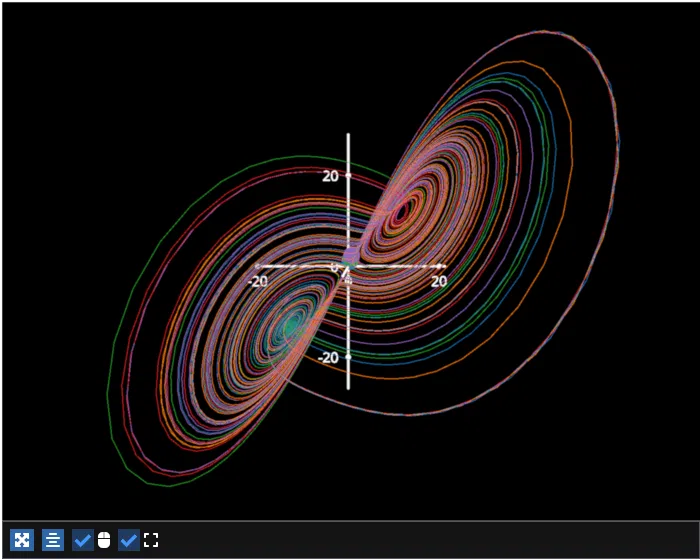Note
Go to the end to download the full example code.
Lorenz System Animation#
Example of the Lorenz attractor.

/opt/hostedtoolcache/Python/3.12.12/x64/lib/python3.12/site-packages/pygfx/objects/_ruler.py:400: RuntimeWarning: divide by zero encountered in divide
screen_full = (ndc_full[:, :2] / ndc_full[:, 3:4]) * half_canvas_size
/opt/hostedtoolcache/Python/3.12.12/x64/lib/python3.12/site-packages/pygfx/objects/_ruler.py:400: RuntimeWarning: invalid value encountered in divide
screen_full = (ndc_full[:, :2] / ndc_full[:, 3:4]) * half_canvas_size
/opt/hostedtoolcache/Python/3.12.12/x64/lib/python3.12/site-packages/pygfx/objects/_ruler.py:412: RuntimeWarning: invalid value encountered in divide
screen_sel = (ndc_sel[:, :2] / ndc_sel[:, 3:4]) * half_canvas_size
/home/runner/work/fastplotlib/fastplotlib/fastplotlib/graphics/features/_base.py:18: UserWarning: casting float64 array to float32
warn(f"casting {array.dtype} array to float32")
# test_example = false
import fastplotlib as fpl
import numpy as np
# generate data
def lorenz(xyz, *, s=10, r=28, b=2.667):
"""
Parameters
----------
xyz : array-like, shape (3,)
Point of interest in three-dimensional space.
s, r, b : float
Parameters defining the Lorenz attractor.
Returns
-------
xyz_dot : array, shape (3,)
Values of the Lorenz attractor's partial derivatives at *xyz*.
"""
x, y, z = xyz
x_dot = s * (y - x)
y_dot = r * x - y - x * z
z_dot = x * y - b * z
return np.array([x_dot, y_dot, z_dot])
dt = 0.01
num_steps = 3_000
lorenz_data = np.empty((5, num_steps + 1, 3))
for i in range(5):
xyzs = np.empty((num_steps + 1, 3)) # Need one more for the initial values
xyzs[0] = (0., (i * 0.3) + 1, 1.05) # Set initial values
# Step through "time", calculating the partial derivatives at the current point
# and using them to estimate the next point
for j in range(num_steps):
xyzs[j + 1] = xyzs[j] + lorenz(xyzs[j]) * dt
lorenz_data[i] = xyzs
figure = fpl.Figure(
cameras="3d",
controller_types="fly",
size=(700, 560)
)
lorenz_line = figure[0, 0].add_line_collection(data=lorenz_data, thickness=.1, cmap="tab10")
scatter_markers = list()
for graphic in lorenz_line:
marker = figure[0, 0].add_scatter(graphic.data.value[0], sizes=16, colors=graphic.colors[0])
scatter_markers.append(marker)
# initialize time
time = 0
def animate(subplot):
global time
time += 2
if time >= xyzs.shape[0]:
time = 0
for scatter, g in zip(scatter_markers, lorenz_line):
scatter.data = g.data.value[time]
figure[0, 0].add_animations(animate)
figure.show()
# set initial camera position to make animation in gallery render better
figure[0, 0].camera.world.z = 80
# NOTE: fpl.loop.run() should not be used for interactive sessions
# See the "JupyterLab and IPython" section in the user guide
if __name__ == "__main__":
print(__doc__)
fpl.loop.run()
Total running time of the script: (0 minutes 21.500 seconds)
